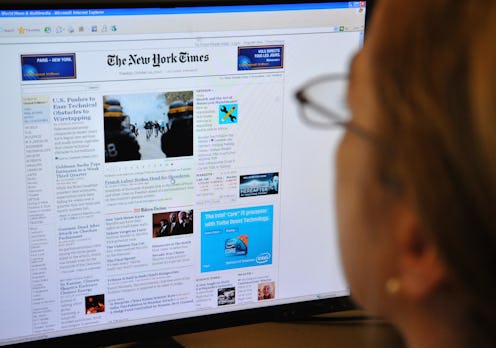Life
The News Is Even More Sexist Than You Realize
Mainstream media has the ability to shape the world, to control what we know and how we perceive it, to change how we frame issues and what our worldview looks like. And so it matters who has that power and who gets coverage — and it's not at all good that men still dominate most news media. According to a new study, men are the focus of a whopping 82 percent of news stories. And that unfortunate truth doesn't seem to be going away anytime soon — especially since imbalanced media coverage is actually self-perpetuating in some ways.
In a paper recently published in the American Sociological Review , researchers looked at data from over 2,000 American newspapers, magazines, and websites between the years 1983 and 2009, examining how often men's names were mentioned versus women's names. And what they found was depressing. According to their analysis, men receive four times as much media coverage, on average, during this period. And there hasn't been much improvement in the 21st century. In recent years, they found, men receive about three times as much coverage.
So why is this? Well, they found that news sources with more women in charge seem to cover women more than those that are still male dominated, but they also note that when, for instance, a woman of a paper that mostly covers men takes over as editor, the ratio of coverage doesn't tend to change. They theorize therefore that more factors are at work than simply the makeup of the newsroom.
Rather, they hypothesize, the problem is that most news coverage "focuses nearly exclusively on the highest strata of occupational and social hierarchies," and there are, sadly, not as many women to be found in these upper echelons. Although women are increasingly making strides in acquiring leadership positions, women still make up only 29 percent of elected officials, and only five percent of Fortune 500 CEOs.
And the problems don't end there.
The trouble, of course, is that this creates a sexist positive feedback loop.
As the authors explain in the paper, "Differential media visibility may reinforce long-standing gender status beliefs and serve as manifestation of these beliefs." They continue:
[Societal] status beliefs regarding men’s greater competence compared to women may be key in sustaining gender inequality. ... These expectations legitimize and normalize men’s overrepresentation in leadership positions and have an adverse effect on female leaders’ ability to exercise power and achieve compliance. ... Media visibility — whether positive or negative — may then further enhance entrenched status beliefs, serving as a signal for what and who society sees as important.
In other words, male-dominated media coverage normalizes the idea of men as important and leaders, which then reinforces the attitudes that make men more likely to become leaders or of otherwise elevated status, which then leads to more male-dominated media coverage.
So how do we fix this "paper ceiling," as these researchers call it? Well, the researchers do note that the problem does seem to be "exacerbated" by having a male-dominated editorial board and a more masculine newsroom culture. Bringing on more women, they suggest, could help shift a media outlet's coverage closer towards gender equality. However, they note that the problem still persists even in newsrooms that are more gender-equal. And sadly, it seems that the problem is probably not going to go away entirely until women become more equal in society as a whole.
Of course, it would be a whole lot easier to do that if the mainstream media wasn't reinforcing sexist world views. But alas, here we are.
Image: Giphy
